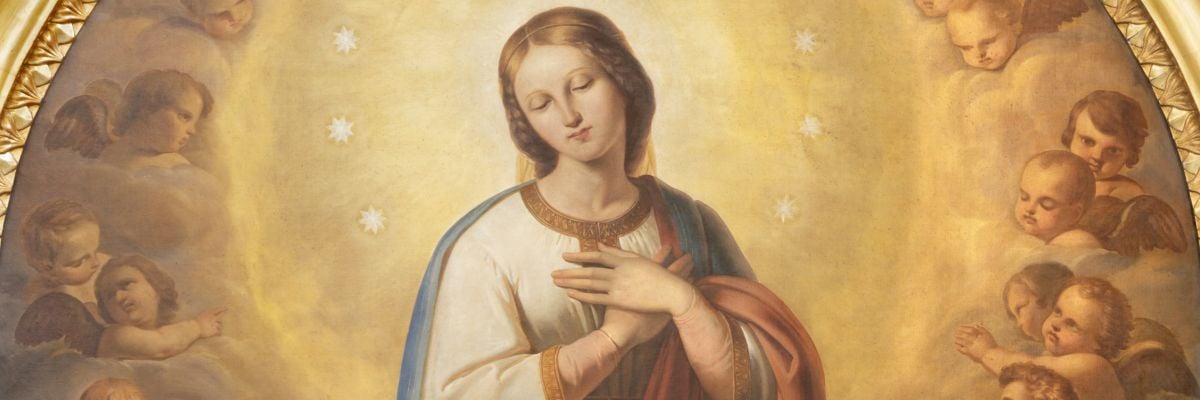
1. Why does the Church teach that Mary was immaculately conceived? Her conception is never even mentioned in Scripture.
Before presenting the scriptural foundations for the Church’s belief in Mary’s Immaculate Conception, know that the person who is posing this question to you is probably operating with the three following misconceptions: (1) The doctrine infringes upon the universality of Christ’s redemption and the unique holiness of God. (2) The Church has no scriptural foundation for the teaching. (3) If any doctrine is not in Scripture it must not be true. Any adequate defense of Our Lady’s Immaculate Conception is incomplete unless all three of these areas are addressed.
The first issue that you need to cover is sola scriptura—the idea that the Bible is the only rule of faith. One of the reasons why our separated brethren have difficulty accepting certain Marian teachings is that they do not understand the scriptural role of sacred Tradition and the magisterium.
The Catholic Church was commissioned by Christ to teach all nations and to teach them infallibly—guided, as he promised, by the Holy Spirit until the end of the world (see John 14:25, 16:13). The mere fact that the Church teaches that something definitely true is a guarantee that it is true (see Luke 10:16).
Besides historical evidence and the authority of Tradition, several biblical texts can be offered. In Genesis 3:15, God states that there is to be an enmity between the “woman” and the serpent, and this enmity is shared between her seed and its seed. Her seed is the messiah, who stands in opposition to the seed of the serpent. The mother of the messiah is said to share the same enmity—total opposition—with Satan.
If Mary, “the woman,” had any sin, then she would not be in complete opposition to the devil. Some argue that the “woman” refers to Eve, but this can not be the complete meaning of the text, as Eve is always associated with her collaboration with the serpent, not her opposition to him. Only Mary, the new Eve, fits the description of the woman in Genesis 3:15.
An implicit reference can also be found in the angel’s greeting to Mary in Luke 1:28: “Hail, full of grace, the Lord is with you.” The phrase “full of grace” is a translation of the Greek word kecharitomene. This word represents the proper name of the person being addressed by the angel, and it therefore expresses a characteristic quality of Mary. Kecharitomene is a perfect passive participle of charitoo, meaning “to fill or endow with grace.” Since this term is in the perfect tense, it indicates a perfection of grace that is both intensive and extensive.
This means that the grace Mary enjoyed was not a result of the angel’s visit, and was not only as “full” or strong or complete as possible at any given time, but it extended over the whole of her life, from conception onward. She was in a state of sanctifying grace from the first moment of her existence to have been called “full of grace.”
Over the centuries, the Fathers and doctors of the Church spoke often about the fittingness of the privilege of Mary’s Immaculate Conception. The dogma is especially fitting when one examines the honor that was given to the Ark of the Covenant. It contained the manna (bread from heaven), stone tablets of the Ten Commandments (the word of God), and the staff of Aaron (an instrument of Israel’s redemption).
If this box was created with such honor—to carry a stick, some bread, and stone tablets—how much more should Mary be made a worthy dwelling place for God himself? She is the new Ark of the Covenant because she carried the real bread from heaven, the Word of God, and the instrument of our redemption, Jesus’ body.
Some argue that the new ark is not Mary but the body of Jesus. Even if this were the case, it is worth noting that 1 Chronicles 15:14 records that the persons who bore the ark were to be sanctified. There would seem to be no sense in sanctifying men who carried a box and not sanctifying the womb who carried the Holy One himself. After all, wisdom will not dwell “in a body under debt of sin” (Wis. 1:4 [NAB]).
2. If Mary is sinless, doesn’t that make her equal to God?
If this question is posed to you, it opens up a wonderful opportunity to show how the Immaculate Conception of Mary glorifies God.
Many people are under the impression that one is not quite human if he or she is sinless. On the contrary, it is when we sin that we fall short of what it means to be fully human. Since we are made in the image and likeness of God, we are called to love as God loves. This is why Christ fully reveals man to himself, as Vatican II says. He shows us what it means to be perfectly human.
In the beginning, God created no one (neither angel nor human) with sin, and yet no one was equal to God. When Adam and Eve sinned, they acted in a manner that was beneath their dignity as beings made in God’s image and likeness. It was their sin that detracted from the glory of God, not their original sinlessness. God’s goodness is most clear when he sanctifies his creation by entering into it fully with the life of his grace.
This is why the sinless souls in heaven give the most glory to God. The unique glory of the Trinity is manifested most clearly in heaven—where is he surrounded by sinless beings. In their sinlessness, God has made them most fully what he intended for them to be. In Mary’s case, her sinlessness gives the most glory to God, since his work is made perfect in her. She is his masterpiece.
3. How could Mary be sinless if in the words of the Magnificat she said that her soul rejoices in God her savior?
The Church does not hesitate to profess that Mary needed a savior. This should be the first issue to address if this question arises. It was by the grace of God—and not the work of Mary—that she was saved from sin in a most perfect manner. By what is called “preservative redemption,” Mary was preserved from sin at the time of her natural conception. John the Baptist was sanctified in the womb prior to his birth (Luke 1:15), and Mary was sanctified at her conception.
It is no difficulty that Christ distributed the grace of Calvary some forty-five years or so before it happened, just as he bestows it upon us 2,000 years after the fact. The Catechism of the Catholic Church states that this gift was given to Mary, making her “redeemed in a more exalted fashion, by reason of the merits of her Son” (492). She has more reason to call God her Savior than we do, because he saved her in an even more glorious manner!
God can “save” a person from a sin by forgiving him or by providing him the grace never to fall into that particular sin. An ancient analogy is often useful to explain this: a person can be saved from a pit in two ways; one can fall into it and be brought out, or one can be caught before falling into it. Mankind is saved in the first manner, and Mary in the second. Both are saved from the pit of sin. If Jesus wished to save his mother from the stain of sin, what is to prevent him?
4. How can you reconcile Mary’s sinlessness with Paul’s statement that all have sinned and fall short of the glory of God?
Though Paul is making a generalization of all humanity, Protestants and Catholics alike would agree that there are exceptions. For example, a child below the age of reason is not capable of committing actual sin. By definition he can’t sin, since sinning requires the ability to reason and the ability to intend to sin. This is indicated by Paul later in the epistle to the Romans when he speaks of the time when Jacob and Esau were unborn babies as a time when they “had done nothing either good or bad” (Rom. 9:11).
Jesus is another significant exception to the rule, having been exempt from actual and original sin (see Heb. 4:15). If Paul’s statement in Romans 3 includes an exception for the new Adam (Jesus), one may argue that an exception for the new Eve (Mary) can also be made.
5. Didn’t the Church just invent the doctrine 150 years ago?
Pope Pius IX officially defined the doctrine of the Immaculate Conception in 1854. When Fundamentalists claim that the doctrine was “invented” at this time, they misunderstand both the history of dogmas and what prompts the Church to issue, from time to time, definitive pronouncements regarding faith or morals. They are under the impression that no doctrine is believed until the pope or an ecumenical council issues a formal statement about it.
Doctrines are defined formally only when there is a controversy that needs to be cleared up or when the magisterium (the Church in its office as teacher; see Matthew 28:18–20, 1 Timothy 3:15, 4:11) thinks the faithful can be helped by particular emphasis being drawn to some already existing belief. The definition of the Immaculate Conception was prompted by the latter motive; it did not come about because there were widespread doubts about the doctrine.
In fact, the Vatican was deluged with requests from people desiring the doctrine to be officially proclaimed. Pope Pius IX, who was highly devoted to the Blessed Virgin Mary, hoped the definition would inspire others in their devotion to her. By understanding the work that God has done in our Lady, all should have greater appreciation for both him and her. For if one member of the body is honored, all should share in its joy (see 1 Corinthians 12:26).



